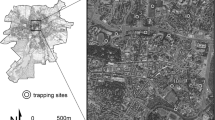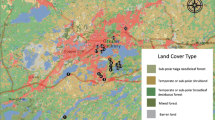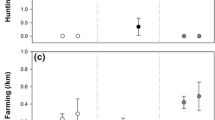Abstract
Urbanisation has become a severe threat to pristine natural areas, causing habitat loss and affecting indigenous animals. Species occurring within an urban fragmented landscape must cope with changes in vegetation type as well as high degrees of anthropogenic disturbance, both of which are possible key mechanisms contributing to behavioural changes and perceived stressors. We attempted to elucidate the effects of urbanisation on the African lesser bushbaby, Galago moholi, by (1) recording activity budgets and body condition (body mass index, BMI) of individuals of urban and rural populations and (2) further determining adrenocortical activity in both populations as a measure of stress via faecal glucocorticoid metabolite (fGCM) levels, following successful validation of an appropriate enzyme immunoassay test system (adrenocorticotropic hormone (ACTH) challenge test). We found that both sexes of the urban population had significantly higher BMIs than their rural counterparts, while urban females had significantly higher fGCM concentrations than rural females. While individuals in the urban population fed mainly on provisioned anthropogenic food sources and spent comparatively more time resting and engaging in aggressive interactions, rural individuals fed almost exclusively on tree exudates and spent more time moving between food sources. Although interactions with humans are likely to be lower in nocturnal than in diurnal species, our findings show that the impact of urbanisation on nocturnal species is still considerable, affecting a range of ecological and physiological aspects.




Similar content being viewed by others
References
Altmann J (1974) Observational study of behavior: sampling methods. Behavior 49:227–267
Altmann J, Muruthi P (1988) Differences in daily life between semiprovisioned and wild-feeding baboons. Am J Primatol 15:213–221. doi:10.1002/ajp.1350150304
Auman HJ, Meathrel CE, Richardson A (2008) Supersize me: does anthropogenic food change the body condition of silver gulls? A comparison between urbanized and remote, non-urbanized areas. Waterbirds 31:122–126. doi:10.1675/1524-4695(2008)31[122:SMDAFC]2.0.CO;2
Beale CM, Monaghan P (2004) Human disturbance: people as predation-free predators? J Appl Ecol 41:335–343. doi:10.1111/j.0021-8901.2004.00900.x
Bearder SK (1987) Lorises, bushbabies, and tarsiers: diverse societies in solitary foragers. In: Smuts BB, Cheney DL, Seyfarth RM, Wrangham RW, Struhsaker TT (eds) Primate societies. University of Chicago Press, Chicago, pp 11–24
Bearder SK, Martin RD (1979) The social organization of a nocturnal primate revealed by radio tracking. In: Amlaner CJ Jr, MacDonald W (eds) A Handbook on biotelemetry and radio tracking. Pergamon, Oxford, pp 633–648
Bearder SK, Martin RD (1980) Acacia gum and its use by bushbabies, Galago senegalensis (Primates: Lorisidae). Int J Primatol 1:103–128
Bejder L, Samuels A, Whitehead H, Finn H, Allen S (2009) Impact assessment research: use and misuse of habituation, sensitisation and tolerance in describing wildlife responses to anthropogenic stimuli. Mar Ecol Prog Ser 395:177–185. doi:10.3354/meps07979
Björntorp P, Rosmond R (2000) Obesity and cortisol. Nutrition 16:924–936. doi:10.1016/S0899-9007(00)00422-6
Boutin S (1990) Food supplementation experiments with terrestrial vertebrates: patterns, problems, and the future. Can J Zool 68:203–220. doi:10.1139/z90-031
Brennan EJ, Else JG, Altmann J (1985) Ecology and behaviour of a pest primate: vervet monkeys in a tourist-lodge habitat. Afr J Ecol 23:35–44. doi:10.1111/j.1365-2028.1985.tb00710.x
Champion T (2001) Urbanization, suburbanization, counterurbanization and reurbanization. In: Paddison R (ed) Handbook of urban studies. SAGE Publication Ltd, London, pp 143–145
Chapman CA, Schoof VA, Bonnell TR, Gogarten JF, Calmé S (2015) Competing pressures on populations: long-term dynamics of food availability, food quality, disease, stress and animal abundance. Philos Trans R Soc B 370:20140112
Coetzee BJ, van der Meulen F, Zwanziger S, Gonsalves P, Weisser PJ (1977) A phytosociological classification of the Nylsvley Nature Reserve. S Afr Natl Sci Progr Rep 20:1–22
Creel S (2001) Social dominance and stress hormones. Trends Ecol Evol 16:491–497
Dantzer B, McAdam AG, Palme R, Boutin S, Boonstra R (2011) How does diet affect fecal steroid hormone metabolite concentrations? An experimental examination in red squirrels. Gen Comp Endocrinol 174:124–131. doi:10.1016/j.ygcen.2011.08.010
Dickman CR, Doncaster CP (1989) The ecology of small mammals in urban habitats II. Demography and dispersal. J Anim Ecol 58:119–127. doi:10.2307/4989
Dixson AF (1989) Sexual selection, genital morphology, and copulatory behaviour in male galagos. Int J Primatol 10:47–55
Fieß M, Heistermann M, Hodges JK (1999) Patterns of urinary and fecal steroid excretion during the ovarian cycle and pregnancy in the African elephant (Loxodonta africana). Gen Comp Endocrinol 115:76–89. doi:10.1006/gcen.1999.7287
Fokidis HB, Orchinik M, Deviche P (2009) Corticosterone and corticosteroid binding globulin in birds: relation to urbanization in a desert city. Gen Comp Endocrinol 160:259–270. doi:10.1016/j.ygcen.2008.12.005
Forthman-Quick DL (1986) Activity budget and the consumption of human food of two troops of baboons, Papio anubis, at Gilgil, Kenya. In: Else JG, Lee PC (eds) Primate ecology and conservation. Cambridge University Press, Cambridge, pp 221–227
French S, Fokidis HB, Moore M (2008) Variation in stress and innate immunity in the tree lizard (Urosaurus ornatus) across an urban–rural gradient. J Comp Physiol B 178:997–1005. doi:10.1007/s00360-008-0290-8
Ganswindt A, Tordiffe ASW, Stam E, Howitt MJ, Jori F (2012) Determining adrenocortical activity as a measure of stress in African bufallo (Syncerus caffer) based on faecal analysis. Afr Zool 47:261–269
George SL, Crooks KR (2006) Recreation and large mammal activity in an urban nature reserve. Biol Conserv 133:107–117. doi:10.1016/j.biocon.2006.05.024
Gorbach SL, Goldin BR (1987) Diet and the excretion and enterohepatic cycling of estrogens. Prev Med 16:525–531
Goymann W (2012) On the use of non-invasive hormone research in uncontrolled, natural environments: the problem with sex, diet, metabolic rate and the individual. Methods Ecol Evol 3:757–765. doi:10.1111/j.2041-210X.2012.00203.x
Harcourt C, Bearder S (1989) A comparison of Galago moholi in South Africa with Galago zanzibaricus in Kenya. Int J Primatol 10:35–45. doi:10.1007/BF02735702
Heistermann M, Palme R, Ganswindt A (2006) Comparison of different enzymeimmunoassays for assessment of adrenocortical activity in primates based on fecal analysis. Am J Primatol 68:257–273. doi:10.1002/ajp.20222
Hill C, Wallace G (2012) Crop protection and conflict mitigation: reducing the costs of living alongside non-human primates. Biodivers Conserv 21:2569–2587. doi:10.1007/s10531-012-0318-y
Hill D (1999) Effects of provisioning on the social behaviour of Japanese and rhesus macaques: implications for socioecology. Primates 40:187–198. doi:10.1007/BF02557710
Hoffman TS, O’Riain MJ (2012) Landscape requirements of a primate population in a human-dominated environment. Front Zool 9:1–17
Kappeler PM (1990) The evolution of sexual size dimorphism in prosimian primates. Am J Primatol 21:201–214. doi:10.1002/ajp.1350210304
Koenig J, Shine R, Shea G (2001) The ecology of an Australian reptile icon: how do blue-tongued lizards (Tiliqua scincoides) survive in suburbia? Wildl Res 28:214–227. doi:10.1071/WR00068
Kristan WB III, Lynam AJ, Price MV, Rotenberry JT (2003) Alternative causes of edge-abundance relationships in birds and small mammals of California coastal sage scrub. Ecography 26:29–44. doi:10.1034/j.1600-0587.2003.03341.x
Manfredo MJ, Dayer AA (2004) Concepts for exploring the social aspects of human–wildlife conflict in a global context. Hum Dimens Wildl 9:1–20. doi:10.1080/10871200490505765
Maréchal L, Semple S, Majolo B, Qarro M, Heistermann M, MacLarnon A (2011) Impacts of tourism on anxiety and physiological stress levels in wild male Barbary macaques. Biol Conserv 144:2188–2193. doi:10.1016/j.biocon.2011.05.010
Martínez-Mota R, Valdespino C, Sánchez-Ramos MA, Serio-Silva JC (2007) Effects of forest fragmentation on the physiological stress response of black howler monkeys. Anim Conserv 10:374–379. doi:10.1111/j.1469-1795.2007.00122.x
McKinney ML (2006) Urbanization as a major cause of biotic homogenization. Biol Conserv 127:247–260. doi:10.1016/j.biocon.2005.09.005
McKinney T (2011) The effects of provisioning and crop-raiding on the diet and foraging activities of human-commensal white-faced Capuchins (Cebus capucinus). Am J Primatol 73:439–448. doi:10.1002/ajp.20919
Morrow CJ, Kolver ES, Verkerk GA, Matthews LR (2002) Fecal glucocorticoid metabolites as a measure of adrenal activity in dairy cattle. Gen Comp Endocrinol 126:229–241
Möstl E, Maggs JL, Schrötter G, Besenfelder U, Palme R (2002) Measurement of cortisol metabolites in faeces of ruminants. Vet Res Commun 26:127–139. doi:10.1023/A:1014095618125
Müller AE (1998) A preliminary report on the social organisation of Cheirogaleus medius (Cheirogaleidae; Primates) in north-west Madagascar. Folia Primatol 69:160–166
Mzilikazi N, Masters JC, Lovegrove BG (2006) Lack of torpor in free-ranging southern lesser galagos, Galago moholi: ecological and physiological considerations. Folia Primatol 77:465–476. doi:10.1159/000095392
Nekaris A, Bearder SK (2007) The lorisiform primates of Asia and mainland Africa: diversity shrouded in darkness. In: Campbell CJ, Fuentes A, Mackinnon KC, Panger M, Bearder SK (eds) Primates in perspective. Oxford University Press, New York, pp 24–45
Nowack J, Mzilikazi N, Dausmann KH (2010) Torpor on demand: heterothermy in the non-lemur primate Galago moholi. PLoS One 5:e10797. doi:10.1371/journal.pone.0010797
Nowack J, Wippich M, Mzilikazi N, Dausmann KH (2013) Surviving the cold, dry period in Africa: behavioral adjustments as an alternative to heterothermy in the African lesser bushbaby (Galago moholi). Int J Primatol 34:49–64
Orams MB (2002) Feeding wildlife as a tourism attraction: a review of issues and impacts. Tour Manag 23:281–293. doi:10.1016/S0261-5177(01)00080-2
Oro D, Cam E, Pradel R, Martínez-Abraín A (2004) Influence of food availability on demography and local population dynamics in a long-lived seabird. Proc R Soc Lond B Biol Sci 271:387–396
Ostrov JM, Hart E (2014) Observational methods. In: Little TD (ed) The Oxford handbook of quantitative methods in psychology: foundations, vol 1. Oxford University Press, Oxford, UK, p 286
Overdorff DJ, Erhart EM, Mutschler T (2005) Does female dominance facilitate feeding priority in black-and-white ruffed lemurs (Varecia variegata) in southeastern Madagascar? Am J Primatol 66:7–22. doi:10.1002/ajp.20125
Palme R, Möstl E (1997) Measurement of cortisol metabolites in faeces of sheep as a parameter of cortisol concentration in blood. Int J Mamm Biol 62:192–197
Parris KM, Hazell DL (2005) Biotic effects of climate change in urban environments: the case of the grey-headed flying-fox (Pteropus poliocephalus) in Melbourne, Australia. Biol Conserv 124:267–276. doi:10.1016/j.biocon.2005.01.035
Pullen SL, Bearder SK, Dixson AF (2000) Preliminary observations on sexual behavior and the mating system in free-ranging lesser galagos (Galago moholi). Am J Primatol 51:79–88
Pusateri DJ, Roth WT, Ross JK, Shultz TD (1990) Dietary and hormonal evaluation of men at different risks for prostate cancer: plasma and fecal hormone-nutrient interrelationships. Am J Clin Nutr 51:371–377
R Development Core Team (2013) R: a language and environment for statistical computing. R Foundation for Statistical computing. Vienna, Austria. ISBN 3-900051-07-0, URL http://www.R-project.org/
Radespiel U, Zimmermann E (2001) Female dominance in captive gray mouse lemurs (Microcebus murinus). Am J Primatol 54:181–192
Ram S, Venkatachalam S, Sinha A (2003) Changing social strategies of wild female bonnet macaques during natural foraging and on provisioning. Curr Sci Bangalore 84:780–790
Rangel-Negrín A, Alfaro JL, Valdez RA, Romano MC, Serio-Silva JC (2009) Stress in Yucatan spider monkeys: effects of environmental conditions on fecal cortisol levels in wild and captive populations. Anim Conserv 12:496–502. doi:10.1111/j.1469-1795.2009.00280.x
Rasoloharijaona S, Rakotosamimanana B, Zimmermann E (2000) Infanticide by a male Milne-Edwards’ sportive lemur (Lepilemur edwardsi) in Ampijoroa, NW-Madagascar. Int J Primatol 21:41–45. doi:10.1023/A:1005419528718
Saj T, Sicotte P, Paterson JD (1999) Influence of human food consumption on the time budget of vervets. Int J Primatol 20:977–994. doi:10.1023/A:1020886820759
Sauther ML (1993) Resource competition in wild populations of ringtailed lemurs (Lemur catta): implications for female dominance. In: Kappeler P, Ganzhorn J (eds) Lemur social systems and their ecological basis. Springer, US, pp 135–152. doi:10.1007/978-1-4899-2412-4_10
Sauvajot R, Buechner M, Kamradt D, Schonewald C (1998) Patterns of human disturbance and response by small mammals and birds in chaparral near urban development. Urban Ecosyst 2:279–297. doi:10.1023/A:1009588723665
Scheun J, Bennett N, Ganswindt A, Nowack J (2014) Spicing up the menu: evidence of fruit feeding in Galago moholi. Primates 55:359–363. doi:10.1007/s10329-014-0420-8
Schülke O, Kappeler PM (2003) So near and yet so far: territorial pairs but low cohesion between pair partners in a nocturnal lemur. Phaner furcifer Anim Behav 65:331–343. doi:10.1006/anbe.2003.2018
Shutt K et al (2014) Effects of habituation, research and ecotourism on faecal glucocorticoid metabolites in wild western lowland gorillas: implications for conservation management. Biol Conserv 172:72–79. doi:10.1016/j.biocon.2014.02.014
Spellerberg IAN (1998) Ecological effects of roads and traffic: a literature review. Glob Ecol Biogeogr 7:317–333. doi:10.1046/j.1466-822x.1998.00308.x
Tecot SR (2013) Variable energetic strategies in disturbed and undisturbed rain forests: Eulemur rubriventer fecal cortisol levels in south-eastern Madagascar. In: Masters J, Gamba M, Génin F (eds) Leaping ahead. Developments in primatology: progress and prospects. Springer, New York, pp 185–195. doi:10.1007/978-1-4614-4511-1_21
Touma C, Palme R (2005) Measuring fecal glucocorticoid metabolites in mammals and birds: the importance of validation. Ann N Y Acad Sci 1046:54–74. doi:10.1196/annals.1343.006
Touma C, Sachser N, Möstl E, Palme R (2003) Effects of sex and time of day on metabolism and excretion of corticosterone in urine and feces of mice. Gen Comp Endocrinol 130:267–278. doi:10.1016/S0016-6480(02)00620-2
Tuomainen U, Candolin U (2011) Behavioural responses to human-induced environmental change. Biol Rev Camb Philos Soc 86:640–657. doi:10.1111/j.1469-185X.2010.00164.x
van Doorn AC, O’Riain MJ, Swedell L (2010) The effects of extreme seasonality of climate and day length on the activity budget and diet of semi-commensal chacma baboons (Papio ursinus) in the Cape Peninsula of South Africa. Am J Primatol 72:104–112. doi:10.1002/ajp.20759
Voragen AGJ (1998) Technological aspects of functional food-related carbohydrates. Trends Food Sci Technol 9:328–335. doi:10.1016/S0924-2244(98)00059-4
Yeo J-H, Neo H (2010) Monkey business: human–animal conflicts in urban Singapore. Soc Cult Geogr 11:681–699. doi:10.1080/14649365.2010.508565
Acknowledgements
We would like to thank the residents of Onderstepoort, Pretoria, as well as Nylsvley Nature Reserve, for the permission to work on their property for the duration of this study. In addition, we would like to thank Ms. L. Prinzloo for assisting in sample collection at Nylsvley Nature Reserve. We would also like to thank Prof. Dr. K.H. Dausmann for logistical support. The research conducted was accomplished with the financial assistance of the Deutsche Forschungsgemeinschaft (DFG; DA 1031/3-1/2) and the DST-NRF SarchI Chair of Mammal Behavioural Ecology and Physiology.
Conflict of interest
The authors declare that they have no competing interests.
Statement of human rights and Informed consent
This article does not contain any studies with human participants performed by any of the authors.
Statement on the welfare of animals
All applicable international, national, and/or institutional guidelines for the care and use of animals were followed.
Author information
Authors and Affiliations
Corresponding author
Additional information
Communicated by: Sven Thatje
Rights and permissions
About this article
Cite this article
Scheun, J., Bennett, N.C., Ganswindt, A. et al. The hustle and bustle of city life: monitoring the effects of urbanisation in the African lesser bushbaby. Sci Nat 102, 57 (2015). https://doi.org/10.1007/s00114-015-1305-4
Received:
Revised:
Accepted:
Published:
DOI: https://doi.org/10.1007/s00114-015-1305-4




